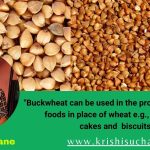Drought resistance strategy in agriculture

A drought is an event of prolonged shortages in the water supply, whether atmospheric, surface water or ground water. It refers to the “deficiency or dearth of water severe enough to check the plant growth.” Drought depletes the soil moisture and cause dehydration in plant tissue.
Drought influences agriculture, hydrology, ecology and socio-economic systems globally. Due to drought each year millions of ton food grains and plant products are lost. In Nepal, the agricultural system is highly dependent on monsoonal rainfall. Moreover, agriculture contributes to around 27% of Nepal’s gross domestic product (GDP), being a very crucial sector in the overall economy of Nepal. However, agriculture in Nepal is suffering from lots of natural hazards, including droughts, floods, soil erosion and landslides. More importantly, droughts have occurred frequently over the past decades in Nepal. For instance, the summer drought in 2015 severely impacted crop yield, affecting more than 80% of the population in the western region. Therefore, knowing drought and managing it by modern scientific technologies is an important aspect of food security.
Introduction
Drought resistance refers to the ability of the crop to continue its growth and reproduction under water- limited environments by adopting various morph-physiological and biochemical means. The drought resistance of plants can be divided into four basic types-drought avoidance, drought tolerance, drought escape, and drought recovery. Various drought-related traits, including root traits, leaf traits, osmotic adjustment capabilities, water potential, ABA content, and stability of the cell membrane, have been used as indicators to evaluate the drought resistance of plants. In the last decade, scientists have investigated the genetic and molecular mechanisms of drought resistance to enhance the drought resistance of various crops, and significant progress has been made with regard to drought avoidance and drought tolerance.
Drought Resistance Strategies
1) Drought escape
It is a strategy of drought resistance where sowing is usually delayed until there is sufficient soil moisture for crop establishment. This enables crop plants to yield satisfactorily with the available soil moisture supply in regions with a characteristic terminal drought. It also includes the development of shorter season cultivars in drier region that enable the crop to escape severe water deficits. This however also reduces the potential yield of crops. Example is tree crop coffee that flower and fruit after drought followed by rain.
2) Dehydration postponement
It is a phenomenon where plants can postpone dehydration by growing deep roots or sealing themselves tightly against transpiration or accumulating large stores of water in fleshy tissues. Dehydration postponer having deep roots accumulate larger amount of water than shallow rooted types but may have water use efficiency identical to that of other plant species. Examples of dehydration postponers are upland rice with deep roots compared to paddy rice or agave with thick cuticle or fleshy tissue.
3) Dehydration tolerance
Tolerance of dehydration is considered to arises at the molecular level. It is depended on the ability of the cells to withstand mechanical injury, the ability of the membranes to withstand degradation, and the ability of the membranes and cytoplasm to withstand denaturation of the proteins. The tolerance of all stresses, including dehydration, depends on the maintenance of the membrane proteins in an undenatured and unaggregated form, or at least repair of lipid structure to its bi-layer form once the initial damage has occurred. Plants with poor dehydration postponement characteristics appear to have greater dehydration tolerance as dehydration postponement allows little selection for dehydration tolerance.
4) Osmoprotectant
Osmoprotectants are small organic molecules with neutral charge and low toxicity at high concentrations that act as osmolytes and help organisms survive extreme osmotic stress. Osmoprotectants can be placed in three chemical classes: betaines and associated molecules, sugars and polyols, and amino acids. These molecules accumulate in cells and balance the osmotic difference between the cell’s surroundings and the cytosol. In high stress conditions, such as drought or high salinity, plants that naturally create or take up osmoprotectants. In plants, their accumulation can increase survival during stresses such as drought. By inducing expression or uptake of these molecules in crops in which they are naturally not present, there is an increase in the areas in which they are able to be grown.
5) Adapting to changing rainfall patterns
Water is the most crucial element needed for growing food. Human-induced climate change is resulting in less and more erratic rainfall, especially in regions where food security is very low. The poor in rural and dry areas will suffer the most and will require cheap and accessible strategies to adapt to erratic weather. Hence, on the basic level farmers will need to adapt with the changing rainfall patterns and conduct agricultural activities accordingly.
6) Drought resistance organic soil
Building a healthy soil is important in enabling farms to cope with drought. Cover crops and crop residues that protect soils from wind and water erosion, and legume inter-crops, manure and composts that build soil rich in organic matter thus enhancing soil structure, are the ways to help increase water infiltration, hold water in the soil, and make nutrients more accessible to the plant. Healthy soils rich in organic matter, as the ones nurtured by agro ecological fertilizers such as green manures, compost, animal dung, etc are less prone to erosion and abler to hold water. Crops fertilized with organic methods have been shown to more successfully resist droughts. The higher water-holding capacity in the organically-fertilized soils seems to explain the yield advantage under drought, as soils in organic fields captured and retained more water than in the chemically fertilized fields. Many fungi associated with plants increase plant resistance to drought and plant water uptake.
7) Molecular breeding for drought resistance
In response to the decrease in productivity due to drought, breeding of crop varieties that can withstand drought stresses and still produce a reliable yield is needed. Drought resistance occurs by modifying the plant’s genes responsible for the mechanism known as the crassulacean acid metabolism, which allows the plants to survive despite low water levels. This is highly beneficial for water-heavy crops such as rice, wheat, soybeans and poplar to accelerate their adaptation to water-limited environments.
There are several methods currently being used to develop drought-tolerant crops: conventional breeding, conventional breeding utilizing marker-assisted selection (MAS) and genetic engineering. New crop varieties with improved drought resistance have been developed through both conventional breeding and MAS. The molecular breeding tool also includes the development of genetically modified crops that can tolerate plant stress.
Following are examples of commercially available drought-tolerant maize, wheat and rice crops.
• Maize
The conventionally-bred maize variety ZM521 was developed by CIMMYT. By repeated cycles of inbreeding and selection, the scientists uncovered the previously hidden genetic traits that enable maize to withstand drought. ZM521 is a maize variety that not only exhibits remarkable vigor when afflicted by water shortage, but also yields 30% to 50% more than traditional varieties under drought.
• Wheat
The wheat varieties Drysdale and Rees are two further notable examples showing that conventional breeding can be used to develop drought tolerance. Using conventional breeding techniques, wheat breeding scientists from Australia’s Commonwealth Scientific and Industrial Research Organization (CSIRO) succeeded in increasing water-use efficiency, an important drought-tolerance strategy. Drysdale, for example, can outperform other varieties by between 10% and 20% in arid conditions and up to 40% under very dry conditions.
• Rice
In 2007, MAS 946-1 became the first drought-tolerant aerobic rice variety released in India. The new variety consumes up to 60% less water than traditional varieties. In addition, MAS 946-1 gives yield comparable with conventional varieties. Several other researches have been made to obtain the drought resistance strain of rice in order to avoid the global food scarcity. The drought resistance variety of rice cultivated in Nepal are DRR dhan 42 , CR dhan 801, Bahuguni dhan-1, and Bahuguni dhan-2. These climate-resilient rice varieties could be a boon for farmers in marginal environments.
Conclusion
The potential for increased irrigation is limited. The increasing population will need to be fed from higher food production per unit land area without the aid of increased irrigation resources. Thus, for improved food production, rainfall and irrigation water will need to be used more efficiently. Also, the importance of understanding and managing crop water deficits is a necessity. Clearly, improving the drought resistance of our food and fiber crops is important strategy to avoid food scarcity in future. Although the new technologies of genetic engineering hold considerable promise, they will still need to be coupled to traditional breeding and agronomy for the maximum utilization.
Writer: Bipana Timalsina (Student, Bsc. Ag IAAS Paklihawa Campus)

 दिल्लीको होटलमा बसेर क्यानडा र अमेरिकामा मानव तस्करी
दिल्लीको होटलमा बसेर क्यानडा र अमेरिकामा मानव तस्करी  अनलाइन जुवा खेलाएर काभ्रेका अनिलले गरे दुई अर्बको कारोबार
अनलाइन जुवा खेलाएर काभ्रेका अनिलले गरे दुई अर्बको कारोबार  मुख्यमन्त्री सोडारीले विश्वासको मत लिन सुदूरपश्चिमको प्रदेश सभा बैठक आव्हान
मुख्यमन्त्री सोडारीले विश्वासको मत लिन सुदूरपश्चिमको प्रदेश सभा बैठक आव्हान  अफगानिस्तानमा बाढीबाट ३१५ भन्दा बढीको मृत्यु
अफगानिस्तानमा बाढीबाट ३१५ भन्दा बढीको मृत्यु  सुँगुरको मिर्गौला प्रत्यारोपण गरिएका रिचर्डको निधन
सुँगुरको मिर्गौला प्रत्यारोपण गरिएका रिचर्डको निधन 


